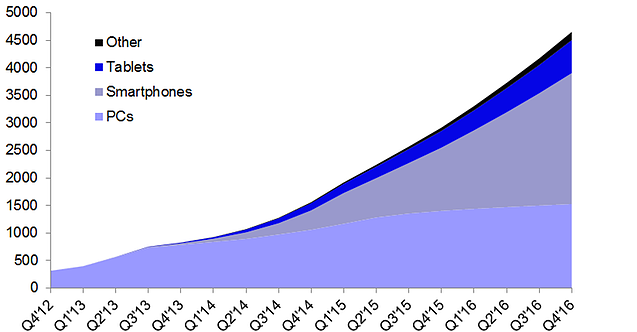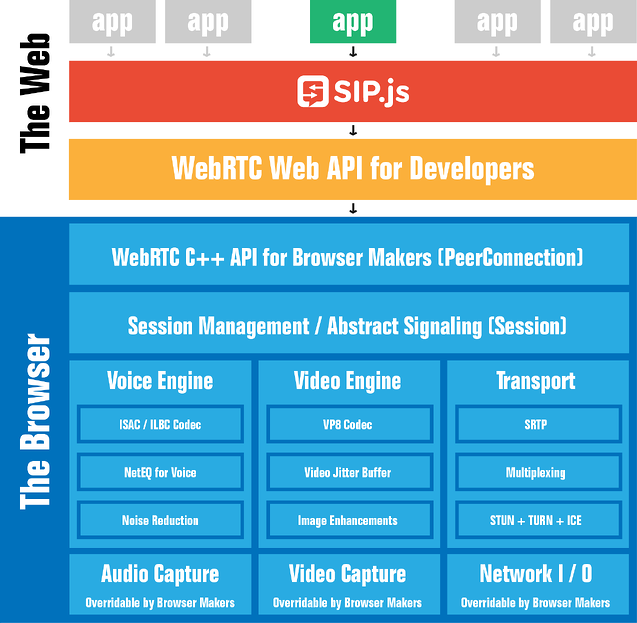WebRTC's most impressive feature is its ability to stream real-time video across browsers without requiring plugins or downloads. And let's not forget that there are zero royalty fees to pay if your app uses Google's standard VP8 codec.
The theoretical advantages of streaming video via WebRTC have always been apparent, but now companies big and small are productizing its potential. In today's climate, there are more reasons than ever to use WebRTC for video calling.
Full Integration
Once upon a time (err...2011), WebRTC was little more than a Google pet project with a fringe user base. Today, WebRTC has been fully integrated into existing platforms and technologies. We incorporated WebRTC into OnSIP's core architecture. Other companies like Twilio have also achieved success with interoperating WebRTC into a hosted VoIP platform.
By integrating WebRTC into existing hosted PBX platforms, developers are given access to preexisting networks of user agents for their WebRTC apps. This allows developers to take advantage of WebRTC features on a massively scalable level. And this means that the consumer can make video calls to any device capable of receiving them without even having to leave their internet browsers.
Increased Adoption

Since its initial release, WebRTC has spawned an entire ecosystem of research, development, and products. Within a year, the technology was enabled on over 1 billion devices. Chrome, Firefox, and Opera all fully adopted WebRTC by 2014. And late last year, even Microsoft embraced the technology (now Apple is the odd man out).
Current predictions maintain that 4 billion devices will be WebRTC enabled by 2016. In an industry-wide context, Gartner predicts that over 100 of the 500 largest global businesses will introduce video-based chat by 2018 for customer-facing interactions. WebRTC's newfound ubiquity gives developers more options when they consider adding streaming video to their apps.
Cost

As an open source standard, WebRTC is a technology that does not require expensive licensing fees to run. Every mechanism that developers need to build WebRTC applications are freely available for use. With its open protocol, WebRTC allows developers to create applications that do not burden the consumer with additional costs at the level of the product.
As WebRTC ages, it has become more tolerant of proprietary video codecs (such as H.264), allowing for a versatility of development options. But WebRTC still allows developers to design apps with free technology, which ultimately offers cheaper prices to consumers.
Efficiency

WebRTC offers a level of efficiency to developers and consumers alike. On the development side, the ability to capture and pass real-time data from the computer’s webcam and microphone to other browsers used to be technically demanding before WebRTC and HTML5.
Now WebRTC’s getUserMedia() command allows browsers to easily retain and transmit this sort of data to other peers (i.e. browsers). With the complex process of capturing real-time media condensed into a single Javascript command, developers do not have to fret about buidling elaborate media engines to run their apps. WebRTC takes care of the grunt work so developers can focus on the more unique aspects of their apps.
On the consumer side, WebRTC requires no downloads or plugins to work. It operates automatically in Chrome, Firefox, and Opera, which frees consumers from worrying about the universe of technological widgets that sometimes seem to create more problems than they solve.
Quality
VP8 is the open source video codec that powers WebRTC. Limits on frame and data rates for VP8 are nonexistent. The width and height measurements come out to 14 bits each, which allows for a maximum resolution of 16384 x 16384 pixels. Its quality has been compared favorably to H.264, a proprietary video codec that requires licensing fees.
WebRTC video currently powers everything from basic video chats to business-grade communications applications. From our own experience, WebRTC has proved to be a versatile real-time video technology that helped us engineer everything from basic video chats to in-browser VoIP phones.

